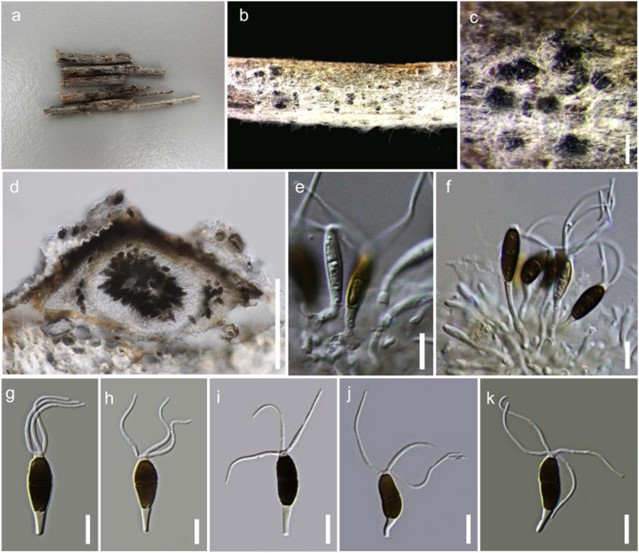Pseudotruncatella arezzoensis R.H. Perera, Camporesi, Maharachch. & K.D. Hyde, in Perera, Maharachchikumbura, Hyde, Bhat, Camporesi, Jones, Senanayake, Al-Sadi, Saichana, Liu & Liu, Phytotaxa 338(2): 181 (2018)
Index fungorum number: IF 553933; MycoBank number: MB 553933; Facesoffungi number: FoF 03839;
Etymology – Refers to the name of the Province in Italy where the fungus was collected.
Saprobic on dead branches of Cytisus and Helichrysum species. Sexual morph Undetermined. Asexual morph Conidiomata 230–275 μm high, 255–280 μm wide, pycnidioid, scattered or gregarious, rounded to oval in outline, unilocular, immersed to semi-immersed, epidermal to sub-epidermal in origin. Peridium 3.6–6.5 μm wide, comprising hyaline to pale brown, thick-walled cells of textura angularis. Conidiophores 11–35 × 1.5–3.3 μm ( x̅ = 21.6 × 2.3 μm, n = 20) diam., arising basal and lateral cavity-surface of conidioma, cylindrical, septate, branched, sometimes unbranched or reduced to conidiogenous cells, smooth, hyaline. Conidiogenous cells 5.7–28 × 1.4–3 μm ( x̅ = 16.6 × 2 μm, n = 25) diam., cylindrical, occasionally ampulliform, holoblastic, annelledic, with a few percurrent proliferations, indeterminate, integrated, hyaline, smooth, thick-walled, with several percurrent proliferations. Conidia 20–25 × 5.4–6.5 μm diam. ( x̅ = 22.1 × 5.8 μm, n = 50), fusiform to clavate, straight, 3-septate, not constricted at septa, bearing 3 apical appendages, guttulate; basal cell 4.5–7.1 × 2.5–3.4 ( x̅ = 5.9 × 2.8 μm) diam., narrowly obconic with a truncate base, hyaline, smooth, thick-walled; 2-median cells together 6.7–8.9 × 4.3–6.5 ( x̅ = 7.7 × 5.2 μm) diam., large, dark brown, thick, smooth-walled; upper median cell subcylindrical to conic, lower median cell narrowly obconic, thick-walled; apical cell conic, hyaline, smooth-walled 1.6–2.8 × 1.4–2.6 ( x = 2.1 × 2.1 μm); apical appendages 20–26 μm ( x̅ = 23.7 μm) long, simple, tubular, hyaline, smooth-walled.
Culture characters – Conidia germinating on PDA within 18 hours. Colonies on PDA reaching 35 mm within 14 days when incubated at 25 °C. Margins effuse, white, flat, lacking aerial mycelium reverse pinkish white.
Material examined– Italy, Croce di Pratomagno (province of Arezzo [AR]), on a dead aerial branch of Cytisus scoparius (L.) Link (Fabaceae), Camporesi Erio, 26 October 2013, IT 1491 (MFLU 15-2285, holotype); ibid., a dead aerial stem of Helichrysum italicum (Roth) G. Don fil. (Asteraceae), 18 July 2013, IT 1322E (MFLU 17-1776, paratype); extype living culture MFLUCC 14-0988; ex-paratype living culture MFLUCC 17-2642.
Notes – Phylogenetic analysis of combined LSU, ITS and SSU sequence data confirms that Pseudotruncatella is phylogenetically distant from members of Sporocadaceae. Pseudotruncatella is similar to Truncatella in forming 3- septate conidia, with pigmented median cells and hyaline apical and basal cells, with apical appendages. However, Pseudotruncatella can be distinguished from Truncatella by dark brown, subcylindrical to conic upper median cell (vs. pale brown to brown, subcylindrical to doliiform) and dark brown, narrowly obconic lower median cell (vs. pale brown to brown, subcylindrical to doliiform) (Steyaert 1949, Nag Raj 1993, Sutton 1996, Lee et al. 2006, Senanayake et al. 2015). Further, Pseudotruncatella forms fusiform to clavate conidia with a thick-walled basal cell, while Truncatella species form fusiform conidia with thin-walled, sometimes deciduous basal cells (Steyaert 1949, Nag Raj 1993, Lee et al. 2006).
Mycohypallage B. Sutton, another somewhat similar coelomycetous genus, which was classified in Phyllachoraceae, lacks molecular data (Sutton 1963, Maharachchikumbura et al. 2015, 2016). This genus shows some morphological similarities to Pseudotruncatella by producing brown conidia with appendages. However, M. margaretae Marinc., Gryzenh. & M.J. Wingf. is distinct from N. arezzoensis by possessing 1-septate conidia with both apical and basal appendages (Marincowitz et al. 2010). The conidiophores of M. congesta (Berk. & Broome) B. Sutton and M. northeae Melnik produce 1-septate conidia with an apical cell modified into a branched appendage (Nag Raj 1993, Marincowitz et al. 2010, Wijayawardene et al. 2106), while our new taxon produces 3-septate conidia. Bleptosporium, Griphosphaerioma, Hyalotiopsis and Monochaetinula, which were maintained in Amphisphaeriales, genera incertae sedis, are also distinct from Pseudotruncatella in morphology. Bleptosporium differs from Pseudotruncatella by forming distoseptate, single appendage-bearing conidia (Morgan-Jones 1974, Nag Raj 1993, Wijayawardene et al. 2016). Griphosphaerioma produces 5-septate conidia, with dichotomously or irregularly branched appendages, which are unrelated to Pseudotruncatella (Morgan-Jones et al. 1972, Sutton 1980, Nag Raj 1993, Wijayawardene et al. 2016). Conidia of Pseudotruncatella resemble those of Hyalotiopsis in color and septation but differ by broader basal cell and cylindrical or obclavate conidia, and a single apical appendage with 2–4 branches (Sutton 1980, Nag Raj & Kendrick 1985, Nag Raj 1993, Wijayawardene et al. 2016). Monochaetinula is distinct from Pseudotruncatella with 3–4-septate, conidia with a single appendaged apical cell and olivaceous to pale brown median cells (Muthumary et al. 1986, Nag Raj 1993, Wijayawardene et al. 2016).

Figure 216 – Pseudotruncatella arezzoensis (Material examined – ITALY, Arezzo Province, Croce di Pratomagno, aerial stem of Helichrysum italicum (Roth) G. Don fil. (Asteraceae), 18 July 2013, Erio Camporesi, IT1322E, MFLU 17-1776, paratype). a Herbarium material. b, c Conidiomata on host. d Vertical section of conidioma. e, f Conidiogenous cells with mature and immature conidia. g-k Conidia. Scale bars: c = 500 µm, d = 200 µm, e-k = 10 µm.
